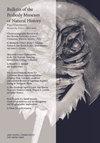利用线粒体基因组探索古埃及鳄鱼木乃伊化的社会和生态背景
IF 0.9
4区 哲学
Q2 BIODIVERSITY CONSERVATION
引用次数: 1
摘要
摘要我们使用同位素和基因组数据来探索与古埃及鳄鱼木乃伊化相关的文化实践的生态和社会背景。耶鲁大学皮博迪自然历史博物馆收藏的四只鳄鱼幼崽木乃伊中发现了古代DNA。先前对鳄鱼木乃伊的基因分析表明,大多数木乃伊代表了新复活的分类单元,即鳄鱼分类单元Geoffroy Saint-Hilaire,1807年。然而,耶鲁大学皮博迪博物馆木乃伊的线粒体基因组数据表明,这些标本代表了博物馆藏品中第一批经过基因组鉴定的尼罗河鳄代表(Crocodylus niloticus Laurenti,1768)。我们在更广泛的现代和历史鳄鱼物种分布背景下探索了这些发现,并对我们理解古埃及涉及鳄鱼的葬礼习俗产生了潜在的影响。本文章由计算机程序翻译,如有差异,请以英文原文为准。
Using Mitogenomes to Explore the Social and Ecological Contexts of Crocodile Mummification in Ancient Egypt
Abstract We used isotopic and genomic data to explore the ecological and social context of cultural practices associated with the mummification of crocodiles in ancient Egypt. Ancient DNA was recovered from four mummified crocodile hatchlings held in the collections of the Peabody Museum of Natural History, Yale University. Previous genetic analyses of crocodile mummies have indicated that most mummies represent the newly resurrected taxon, Crocodylus suchus Geoffroy Saint-Hilaire, 1807. However, mitogenomic data for the Yale Peabody Museum mummies indicates that these specimens represent the first genomically authenticated representatives of the Nile crocodile (Crocodylus niloticus Laurenti, 1768) in museum collections. We explore these findings within the broader context of modern and historical distributions of both crocodile species and the potential implications for our understanding of funerary practices involving crocodiles in ancient Egypt.
求助全文
通过发布文献求助,成功后即可免费获取论文全文。
去求助
来源期刊

Bulletin of the Peabody Museum of Natural History
BIODIVERSITY CONSERVATION-ECOLOGY
CiteScore
2.40
自引率
0.00%
发文量
6
审稿时长
>12 weeks
期刊介绍:
The Bulletin of the Peabody Museum of Natural History publishes original research based on specimens, artifacts and related materials maintained in the collections of the Yale Peabody Museum of Natural History’s curatorial divisions. The Bulletin is published twice a year, in April and October.
 求助内容:
求助内容: 应助结果提醒方式:
应助结果提醒方式:


